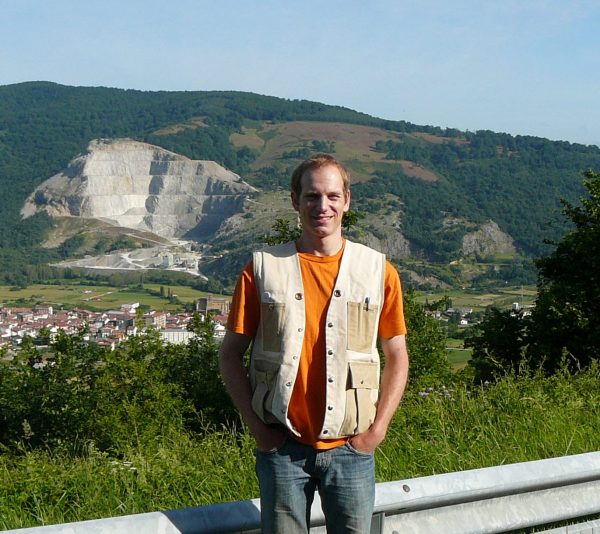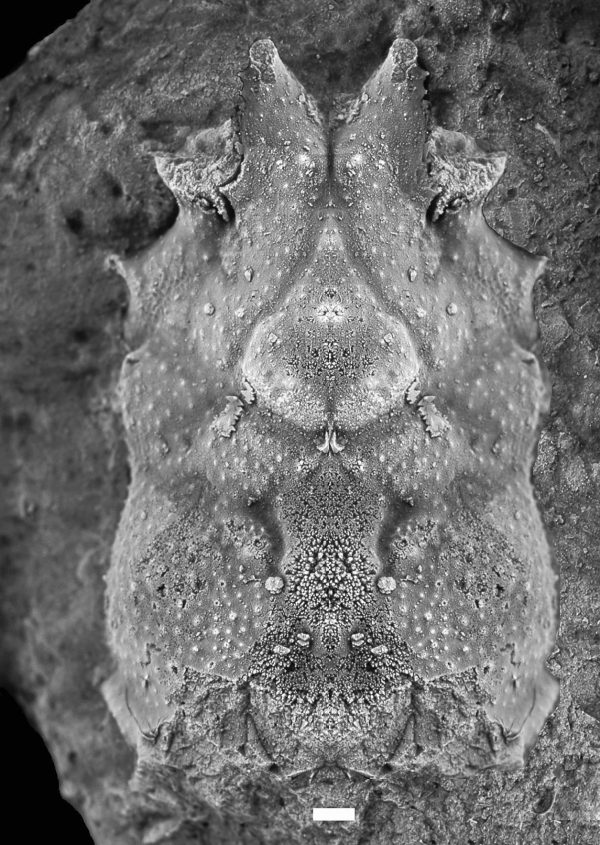A University of Florida scientist has discovered a record biodiversity hotspot in Spain for 100-million-year-old crustaceans with possible implications for present-day species living in reefs, which are declining worldwide.

Photo courtesy of Adiël Klompmaker
Decapod crustaceans, including crabs, shrimp and lobsters, are vital parts of the food chain, contributing to reef health and serving as food for many larger marine organisms. Study of their early evolution may help researchers better understand how present-day species are affected by reefs declining due to changes such as ocean acidification and coral bleaching, which also threaten the animals they support.
A study published online Wednesday in Cretaceous Research reports 36 species from the abandoned Koskobilo quarry located in a fossil reef in northern Spain, including eight new species and the oldest-known spider crabs.
“The reef in Spain died soon after many decapods were still around. Something must have happened in the environment that caused reefs in the area to vanish, and with it, probably many of the decapods that were living in these reefs,” said study author Adiël Klompmaker, a postdoctoral researcher at the Florida Museum of Natural History on the UF campus. “Not many decapods are known from the time after the reefs disappeared in the area.”
The fauna of the locality in Spain exhibited a higher diversity than previously known, and included fossil crabs, hermit crabs and squat lobsters, said Klompmaker, who began research for the project as a graduate student at Kent State University. The fossils represent all dominant decapod groups found in reefs today, except true lobsters and shrimp, which may not have been preserved.
“Today’s decapods can adapt to a new environment without reefs, migrate elsewhere or go extinct,” Klompmaker said. “By documenting what happened in the past, we may provide clues as to what could happen to decapod crustaceans such as crabs, shrimp and lobsters in today’s deteriorating reefs.”

Photo by Adiël Klompmaker
Klompmaker researched 20 localities worldwide to determine the Koskobilo quarry is the most diverse locality for decapods in the Cretaceous period 145 to 66 million years ago. The research also shows that ancient decapods living within reefs are more diverse than those living in other parts of the ocean, which is similar to diversity patterns today.
“This shows that reefs were a popular place to feed, mate and seek shelter for decapods,” Klompmaker said. “Thus, not much has changed from this perspective since the Cretaceous. Decapods still really like living in coral reefs, although today many different decapod families inhabit them.”
Tropical temperatures dominated the Cretaceous period and sea levels were extremely high worldwide. The quarry, which would have been underwater at the time, is now about 35 miles from the Atlantic Ocean in northern Spain, Klompmaker said. The locality’s age was determined based on ammonite fossils, ancient squid-like animals with external shells.
The study is important for understanding decapod evolution because multiple species were grouped within the same genus, rather than just one, said Francisco Vega, a paleontologist at the Universidad National Autonoma de Mexico.
“We would not expect such a high diversity at that time because there are very few records of crabs then,” Vega said. “Also, by that time, the group was represented by so many species in a reef environment, and the number of species today is about the same, which is very significant since the diversity of the communities has prevailed ever since.”
Klompmaker collected fossils in the Koskobilo quarry during three field trips in 2008, 2009 and 2010 with a team of researchers from Spain, the Netherlands and the U.S. New species were identified by analyzing the morphology, or physical characteristics of the fossils, which include three-dimensional impressions of the decapod shell.
“We went there in 2008 and in the first two hours found two new species,” Klompmaker said. “That’s quite amazing — it just doesn’t happen every day.”
Learn more about the Invertebrate Paleontology Collection at the Florida Museum.